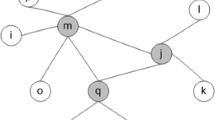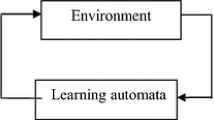Abstract
Mobile peer-to-peer (MP2P) networks refer to the peer-to-peer overlay networks superimposing above the mobile ad-hoc networks. Heterogeneity of capacity and mobility of the peers as well as inherent limitation of resources along with the wireless networks characteristics are challenges on MP2P networks. In some MP2P networks, in order to improve network performances, special peers, are called super-peers, undertake to perform network managerial tasks. Selection of super-peers, due to their influential position, requires a protocol which considers the capacity of peers. Lack of general information about the capacity of other peers, as well as peers mobility along with dynamic nature of MP2P networks are the major challenges that impose uncertainty in decision making of the super-peer management algorithms. This paper proposes an adaptive super-peer selection algorithm considering peers capacity based on learning automata in MP2P networks, called SSBLA. In the proposed algorithm, each peer is equipped with a learning automaton which is used locally in the operation of super-peer selection by that peer. It has been shown that the suggested algorithm is superior to the existing algorithms. The results of the simulation show that the proposed algorithm can maximize capacity utilization by minimum number of super-peer and improve robustness against failures of super-peers while minimizing selection communication overhead.































Similar content being viewed by others

References
Elgazzar K, Ibrahim W, Oteafy S, Hassanein HS (2013) “RobP2P: a robust architecture for resource sharing in mobile peer-to-peer networks”, presented at the The 4th International Conference on Ambient Systems, Networks and Technologies (ANT 2013)
Guo FA, Xu JB (2011) Searching methods of MP2P based on diffusion strategy of resources index. Comput Netw Inf Secur 3:26–33
Gholami S, Meybodi MR, Saghiri AM (2014) “A learning automata-based version of SG-1 protocol for super-peer selection in peer-to-peer networks,” in the 10th International Conference on Computing and Information Technology (IC2IT2014), pp. 189–201
Bin L, Huan XY, Yan Z, Ting CB, Jian W (2012) “The algorithm of super-peer selection based on dynamic performance in mobile peer-to-peer network,” presented at the EICE2012, Macau, China
Androutsellis-Theotokis S, Spinellis D (2004) A survey of peer-to-peer content distribution technologies. ACM Comput Surv 36:335–371
Lua EK, Crowcroft J, Pias M, Sharma R, Lim S (2005) A survey and comparison of peer-to-peer overlay network schemes. IEEE Commun Surv Tutorials 72–93
Han JS, Lee KJ, Song JW, Yang SB (2008) “Mobile peer-to-peer systems using super peers for mobile environments,” presented at the The International Conference on Information Networking 2008, Busan, Korea
Kim J-H, Song J-W, Kim T-H, Yang S-B (2011) An enhanced double-layered P2p system for the reliability in dynamic mobile environments. Ad Hoc Sensor Wirel Netw 30:467
Mahdy AM, Deogun JS, Wang AJ (2007) “A dynamic approach for the selection of super peers in ad hoc networks” presented at the the Sixth International Conference on Networking Martinique, France
Henriques PMDS (2011) A lightweight distributed super peer election algorithm for unstructured dynamic P2P systems,” Master of Electrical Engineering and Computer, Department of Electrical Engineering, the Faculty of Sciences and Technology New University of Lisbon
Fitzek FHP, Charaf H (2009) Introduction to WLAN IEEE802.11 communication on mobile devices. In: Mobile Peer to Peer (P2P): A Tutorial Guide. John Wiley & Sons
Schiller JH (2003) Mobile communications, 2nd ed.: Addison-Wesley
Okdem S (2015) A cross-layer adaptive mechanism for low-power wireless personal area networks. Comput Commun
Najim K, Poznyak AS (1994) Learning automata: theory and application. In: Tarrytown
Thathachar KSNMA L (1989) Learning automata: An introduction. Prentice-Hall
Castro MC, Kassler AJ, Chiasserini C-F, Casetti C, Korpeoglu I (2010) Peer-to-peer overlay in mobile ad-hoc networks. In: Shen X, Yu H, Buford J, Akon M (eds) Handbook of peer-to-peer networking. Springer, New York, pp 1045–1080
Seet BC (2005) “Mobile P2Ping: a super-peer based structured P2P system using a fleet of city buses,” presented at the IEEE3th International Conference on Pervasive Computing and Communications Workshops, Kauai Island, Hawaii
Tang B, Zhou Z, Kashyap A, Chiueh TC (2005) “An integrated approach for P2P file sharing on multi-hop wireless networks,” presented at the IEEE International Conference on Wireless And Mobile Computing, Networking And Communications, Montreal, Canada
Gerla M, Tsai JTC (1995) Multicluster, mobile, multimedia radio network. Wirel Netw 1:255–265
Wang TI, Tsai KH, Lee YH (2004) “Crown: an efficient and stable distributed resource lookup protocol distributed resource lookup protocol,” presented at the International Conference EUC 2004, Aizu-Wakamatsu, Japan
Wei Y, Xie G, Li Z (2007) A hierarchical cross-layer protocol for group communication in MANET,” presented at the Telecommunications and Malaysia International Conference on Communications, Penang, Malaysia
Kim SK, Lee KJ, Yang SB (2011) An enhanced super-peer system considering mobility and energy in mobile environments,” in 6th International Symposium on Wireless and Pervasive Computing (ISWPC) pp. 1–5
Lee K-J, Choi J-H, Yang S-B (2012) Fuzzy inference-based super peer selection for a practical double-layered mobile peer-to-peer system. Ad Hoc Sensor Wirel Netw 21:327–351
Merz P, Priebe M, Wolf S (2008) Super-peer selection in peer-to-peer networks using network coordinates,” In: Internet and Web Applications and Services, 2008. ICIW’08. Third International Conference on, pp. 385–390
Torkestani JA, Meybodi MR (2010) An intelligent backbone formation algorithm for wireless ad hoc networks based on distributed learning automata. Comput Netw Int J Comput Telecommun Netw 54(5):826–843
Safavi S, Meybodi MR, Esnaashari M (2014) Learning automata based face-aware Mobicast. Wirel Pers Commun 77:1923–1933
Misra S, Chatterjee SS, Guizani M (2015) Stochastic learning automata‐based channel selection in cognitive radio/dynamic spectrum access for WiMAX networks. Int J Commun Syst 28:801–817
Krishna PV, Misra S, Joshi D, Gupta A, Obaidat MS (2014) Secure socket layer certificate verification: a learning automata approach. Secur Commun Netw 7:1712–1718
Kumar N, Lee J-H (2015) Collaborative-learning-automata-based channel assignment with topology preservation for wireless mesh networks under QoS constraints. IEEE Syst J 9:675–685
Kumar N, Lee J-H, Rodrigues JJ (2015) Intelligent mobile video surveillance system as a bayesian coalition game in vehicular sensor networks: learning automata approach. IEEE Trans Intell Transp Syst 16:1148–1161
Kumar N, Misra S, Obaidat M, Rodrigues J, Pati B (2014) Networks of learning automata for the vehicular environment: a performance analysis study. IEEE Wirel Commun 21:41–47
Kumar N, Misra S, Obaidat MS (2015) Collaborative learning automata-based routing for rescue operations in dense urban regions using vehicular sensor networks. IEEE Syst J 9:1081–1090
Saghiri AM, Meybodi MR (2015) A distributed adaptive landmark clustering algorithm based on mOverlay and learning automata for topology mismatch problem in unstructured peer‐to‐peer networks. Int J Commun Syst
Saghiri AM, Meybodi MR (2015) A self-adaptive algorithm for topology matching in unstructured peer-to-peer networks. J Netw Syst Manag 1–34
Saghiri AM, Meybodi MR (2016) An approach for designing cognitive engines in cognitive peer-to-peer networks. J Netw Comput Appl 70:17–40
Polatoglou M, Nicopolitidis P, Papadimitriou GI (2014) On low‐complexity adaptive wireless push‐based data broadcasting. Int J Commun Syst 27:194–200
Nicopolitidis P, Chrysostomou C, Papadimitriou GI, Pitsillides A, Pomportsis AS (2014) On the efficient use of multiple channels by single‐receiver clients in wireless data broadcasting. Int J Commun Syst 27:513–520
Nicopolitidis P (2015) Performance fairness across multiple applications in wireless push systems. Int J Commun Syst 28:161–166
Misra S, Krishna PV, Saritha V, Obaidat MS (2013) Learning automata as a utility for power management in smart grids. IEEE Commun Mag 51:98–104
Hasanzadeh M, Meybodi MR (2015) Distributed optimization Grid resource discovery. J Supercomput 71:87–120
Morshedlou H, Meybodi MR (2014) Decreasing impact of sla violations: a proactive resource allocation approach for cloud computing environments. IEEE Trans Cloud Comput 2:156–167
Varga A, Hornig R An overview of the OMNeT++ simulation environment. In: The 1st international conference on Simulation tools and techniques for communications, networks and systems & workshops
Broch J, Maltz DA, Johnson DB, Hu Y-C, Jetcheva J (1998)A performance comparison of multi-hop wireless ad hoc network routing protocols. In: The 4th Annual ACM/IEEE International Conference on Mobile Computing and Networking (MobiCom’98), pp. 85–97
Montresor A (2004) A robust protocol for building superpeer overlay topologies. In: Fourth International Conference on Peer-to-Peer Computing, pp. 202–209
Meng W, Wang X, Liu S Distributed load sharing of an inverter-based microgrid with reduced communication. IEEE Trans Smart Grid. doi:10.1109/TSG.2016.2587685
Author information
Authors and Affiliations
Corresponding author
Appendix
Appendix
In this section, we present the results of statistical tests. To evaluate the result of experiment, one way ANOVs and tuky statistical tests are used.
Rights and permissions
About this article
Cite this article
Amirazodi, N., Saghiri, A.M. & Meybodi, M. An adaptive algorithm for super-peer selection considering peer’s capacity in mobile peer-to-peer networks based on learning automata. Peer-to-Peer Netw. Appl. 11, 74–89 (2018). https://doi.org/10.1007/s12083-016-0503-y
Received:
Accepted:
Published:
Issue Date:
DOI: https://doi.org/10.1007/s12083-016-0503-y



